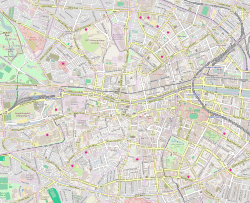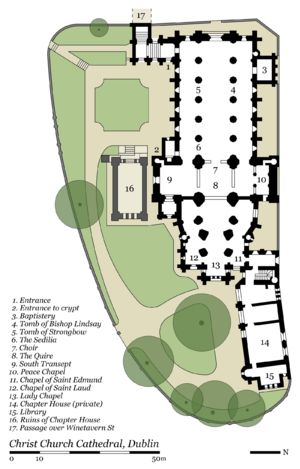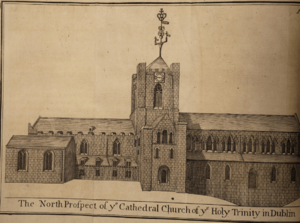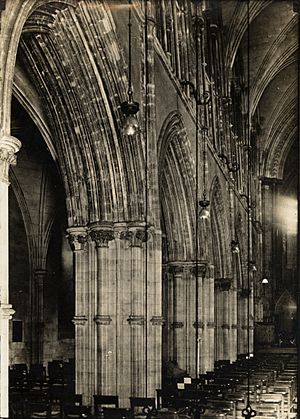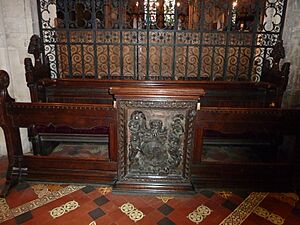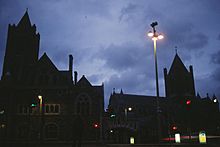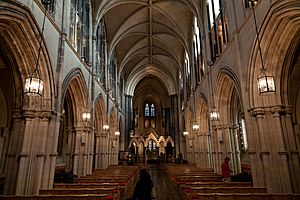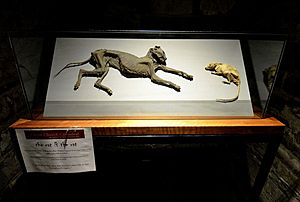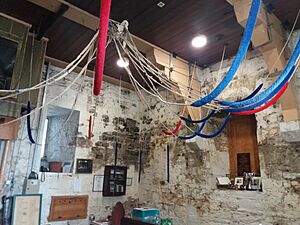Christ Church Cathedral, Dublin facts for kids
Quick facts for kids Christ Church Cathedral |
|
|---|---|
| Cathedral of the United Dioceses of Dublin and Glendalough and Metropolitan Cathedral of the United Provinces of Dublin and Cashel | |
| Cathedral Church of the Holy Trinity | |
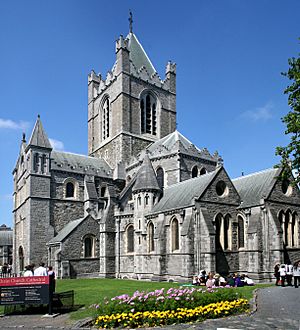 |
|
| 53°20′35″N 06°16′17″W / 53.34306°N 6.27139°W | |
| Location | Christchurch Pl, Wood Quay, Dublin 8 |
| Country | Ireland |
| Denomination | Church of Ireland |
| Previous denomination | Roman Catholic |
| Churchmanship | High Church |
| History | |
| Founded | c. 1030 |
| Founder(s) | Sigtrygg Silkbeard |
| Dedication | Holy Trinity |
| Relics held | Heart of Lorcán Ua Tuathail |
| Past bishop(s) | Dúnán Lorcán Ua Tuathail Henry de Loundres Richard Northalis William Rokeby William Plunket, 4th Baron Plunket |
| Architecture | |
| Style | Gothic/Romanesque |
| Specifications | |
| Bells | 19 |
| Tenor bell weight | 2 long tons 5 cwt 0 qr 0 lb (5,040 lb or 2.286 t) |
| Administration | |
| Parish | Christ Church Cathedral |
| Diocese | Diocese of Dublin and Glendalough |
| Province | Dublin |
Christ Church Cathedral, also known as The Cathedral of the Holy Trinity, is a very old church in Dublin, Ireland. It's one of two medieval cathedrals in the city, the other being St Patrick's Cathedral. Today, it's the main church for the Church of Ireland in Dublin.
The cathedral was first built around 1030 by the Viking king Sitric Silkenbeard. Later, in the late 1100s, it was rebuilt with stone by a Norman leader named Strongbow. It was made even bigger in the early 1200s. After some damage in the 1500s, the cathedral was greatly fixed up and rebuilt in the late 1800s. This is why it looks the way it does today, with its tall tower and unique covered bridge.
Contents
About Christ Church Cathedral
Christ Church Cathedral is the main church for the Church of Ireland's Archbishop of Dublin. It's located in the old part of medieval Dublin, near Wood Quay. Even though it's a very old building, new roads and buildings around it have changed how it looks in the city. It's the only one of Dublin's main churches that you can clearly see from the River Liffey.
First Church Building
The first church was likely started after 1028. This was when King Sitric Silkenbeard, a Viking king of Dublin, went on a trip to Rome. The first bishop of Dublin, named Dúnán, was in charge. The church was built on high ground overlooking the Viking settlement. King Sitric gave land to help support the church.
In 1163, Saint Laurence O'Toole, who became the second Archbishop of Dublin, changed Christ Church into a priory. This meant it was run by a group of monks called Augustinian Canons. It became one of the richest religious places in Ireland.
Norman Changes
In 1171, King Henry II visited the cathedral for a Christmas service. This was an important event for him.
In the 1180s, Strongbow and other Norman leaders helped rebuild Christ Church. It was originally made of wood, but they rebuilt it with stone. They added a choir, chapels, and a crypt.
In the 1230s, much of the main part of the church, called the nave, was built. Its design was inspired by English Gothic churches.
In 1300, an agreement called the Pacis Compostio was made. This agreement said that both Christ Church and St Patrick's Cathedral were equally important cathedrals for Dublin.
In the 1350s, John de St Paul, the Archbishop of Dublin, made the church even bigger. He added a "long choir" and an organ.
In 1487, a young boy named Lambert Simnel was supposedly crowned "King Edward VI" here. He was a pretender to the throne, trying to take over from King Henry VII of England.
Changes During the Reformation
During the time of the Reformation, King Henry VIII changed Christ Church from a priory (run by monks) to a cathedral run by a Dean and Chapter (a group of clergy). The last leader of the priory became the first Dean of Christ Church.
Later, in 1551, church services were sung in English for the first time in Ireland, instead of Latin. In 1560, the Bible was also read in English here.
Later Years and Restoration
In 1562, part of the nave (the main part of the church) collapsed. This was because its foundations were in soft ground. Some repairs were done, but much of the damage remained for a long time.
For much of the 1800s, the building was in poor condition. From 1871 to 1878, the cathedral was greatly renovated and rebuilt. A wealthy distiller named Henry Roe paid for most of this work. He spent a huge amount of money, which would be millions of euros today!
During this restoration, many parts were rebuilt, including the tower and the south nave. New features like the flying buttresses (supports on the outside) were added. The famous covered footbridge, which connects the cathedral to the Synod Hall, was also built at this time.
Inside the Cathedral
The main part of the cathedral is called the nave. Here, you can find the tomb of Strongbow. He was a Norman leader who came to Ireland in the 1100s. His arrival was a big moment in Irish history. The original tomb was damaged in 1562 when the roof collapsed. The tomb you see today is a replacement from that time. Next to it is a smaller figure, possibly a child, wearing chain mail.
The Crypt
Christ Church has the largest cathedral crypt (an underground room) in Britain or Ireland. It's about 63 meters long and was built in 1172–1173. After being fixed up in the early 2000s, visitors can now explore it.
The crypt holds many interesting things, including:
- Some of the oldest carvings in Ireland that are not religious. These two statues used to stand outside Dublin's old city hall.
- A special tabernacle and candlesticks that were used when the cathedral briefly became a Roman Catholic church again in 1690.
- Old wooden stocks from 1670, which were used to punish people who broke rules in the area around the cathedral.
- Historic books and items used in church services.
- "The Cat & The Rat" – these are the mummified remains of a cat and a rat found in the organ pipes! They are displayed with a story about how they got there.
Synod Hall and Bridge
At the west end of the cathedral, there's a stone bridge that connects to the old Synod Hall. This hall was built where another old church used to be. It was once used for important church meetings. Today, it's home to the "Dublinia" exhibition, which teaches visitors about medieval Dublin.
Cathedral's Role
Christ Church is a busy place of worship for the Church of Ireland. It hosts important events like the Citizenship Service and ordinations, where new priests are made.
Two Cathedrals in Dublin
For a long time, both Christ Church and St Patrick's Cathedral were considered cathedrals for Dublin. This was unusual! In 1300, they made an agreement called Pacis Compositio to share their status. This agreement said things like:
- The Archbishop of Dublin should be officially welcomed at Christ Church.
- Christ Church was the older and more senior cathedral.
- The two cathedrals would work together and share their freedoms.
Today, Christ Church is the main cathedral for the Church of Ireland in Dublin. The Roman Catholic Archbishop of Dublin uses St Mary's as his main church, but it's called a "pro-cathedral" because the Catholic Church still sees Christ Church as the historical seat.
Music at Christ Church
Christ Church Cathedral has a long history of music. It has a famous cathedral choir and a girls' choir. Music is a very important part of the services and life at the cathedral.
The Bells of Christ Church
Christ Church Cathedral has had bells for a very long time. In 1597, a gunpowder explosion nearby damaged the tower and cracked the bells.
Over the years, new bells were added and recast. In 1999, seven more bells were added, bringing the total to 20 bells! This makes it one of the few places in the world with so many bells that can be rung in a special way called "change ringing." Bell ringing is a regular activity at the cathedral, especially on Sundays and for practice on Friday nights.
Visiting the Cathedral
Christ Church Cathedral does not receive regular money from the government. While everyone is welcome to visit and pray, there is a fee for sightseeing. You can also buy a ticket that includes entry to the "Dublinia" exhibition next door. There's also a gift shop where you can find souvenirs and music from the cathedral choirs.
Christ Church in Media
The cathedral has been used as a filming location for TV shows set in medieval times. For example, parts of the TV series Reign and The Tudors were filmed here. You can even see some of the costumes worn by the actors in the cathedral crypt!
Burials at Christ Church
Many important people are buried or remembered at Christ Church Cathedral, including:
- The heart of Lorcán Ua Tuathail (Saint Laurence O'Toole), a former Archbishop of Dublin.
- Strongbow, the Norman leader.
Theft of Saint Laurence O'Toole's Heart
In 2012, the heart of Saint Laurence O'Toole was stolen from the cathedral. But in 2018, the Irish police found it and returned it after a special investigation!
See also
 In Spanish: Catedral de la Santísima Trinidad (Dublín) para niños
In Spanish: Catedral de la Santísima Trinidad (Dublín) para niños
- List of Gothic Cathedrals in Europe


